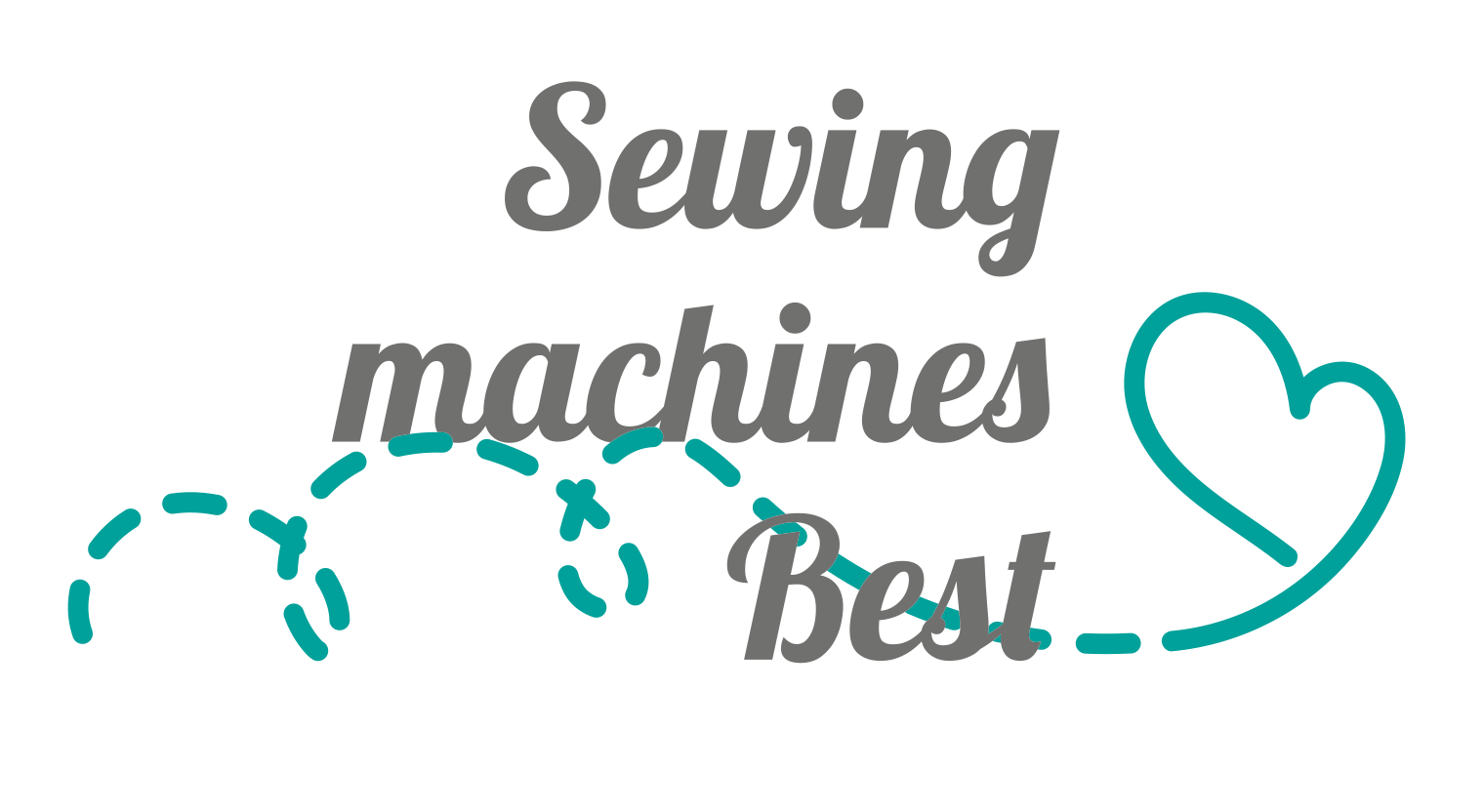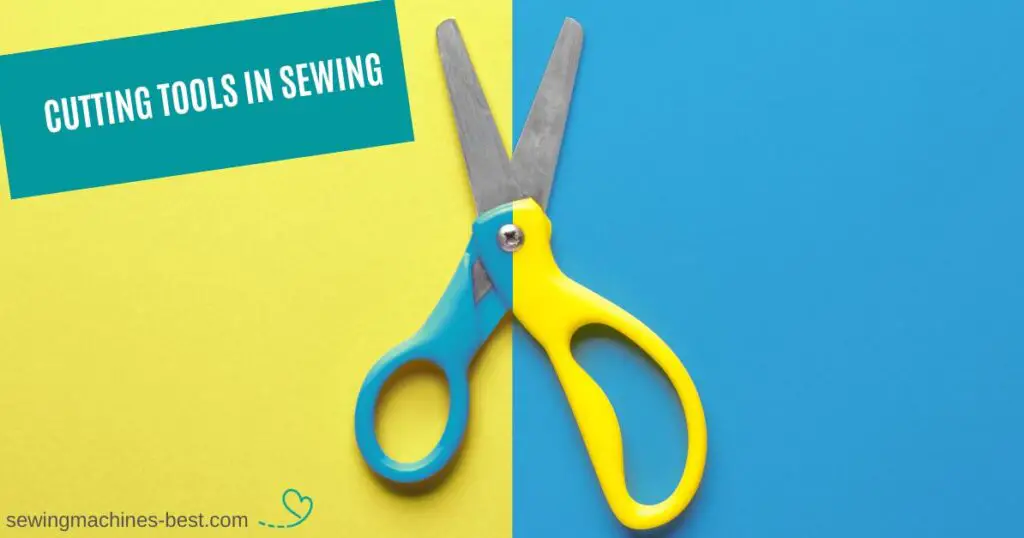Hello! If you are reading this article, you may be interested to know more about what cutting tools are used in sewing and what they are needed for.
In this article, we will talk about the essential cutting tools in sewing, that can be found in any sewing room, special cutting tools for needlework, and additional cutting tools for sewing, as well as give some recommendations on what to pay attention to when choosing cutting tools for sewing.

So let’s get started.
Contents
- 1 Why is it important to use the correct cutting tools in sewing?
- 2 Types of cutting tools in sewing
- 3 Fabric scissors are the essential cutting tool for sewing
- 4 How to choose cutting tools for sewing?
- 5 Conclusion
- 6 FAQ
Why is it important to use the correct cutting tools in sewing?
Sewing cutting tools like scissors and rotary cutters are essential because they help you cut fabric accurately and neatly. They make your sewing projects look better and fit well.
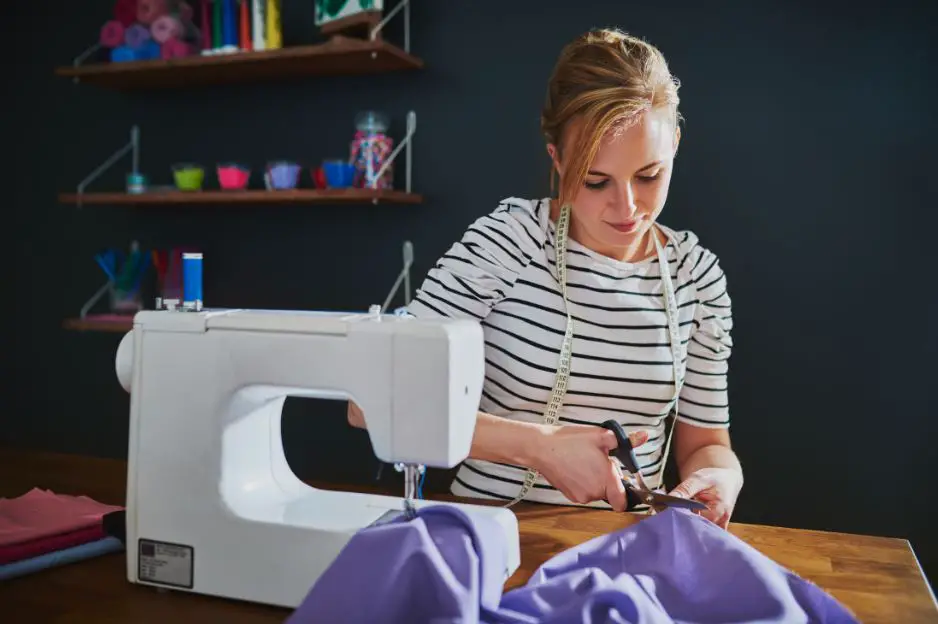
These tools are efficient and save you time, especially when you’re working on big or complex projects. They also come in different types for various fabrics, making them versatile. Plus, they keep you safe with features like blade covers and ergonomic handles, so you can enjoy sewing without worries.
Types of cutting tools in sewing
I would like to emphasize that the quality of the finished sewing project largely depends on the quality of the cutting tools.
Of course, there are other important aspects of sewing projects, such as the quality of fabrics or thread, but it is high-quality cutting tools that allow you to perform this work at a high level with pleasure.
Professionals know that various cutting tools are required for different sewing projects. In this review, we will look at different types of cutting tools for sewing, moving from basic to additional tools.
And we will start with the most basic cutting tool in sewing – fabric scissors.
Fabric scissors are the essential cutting tool for sewing
Sewing scissors, thread, needle, and sewing machine are perhaps the most basic items in sewing, without which it is impossible to imagine any sewing project, but fabric scissors take a special place.
It is difficult to find a cutting tool more in demand in sewing than fabric scissors.
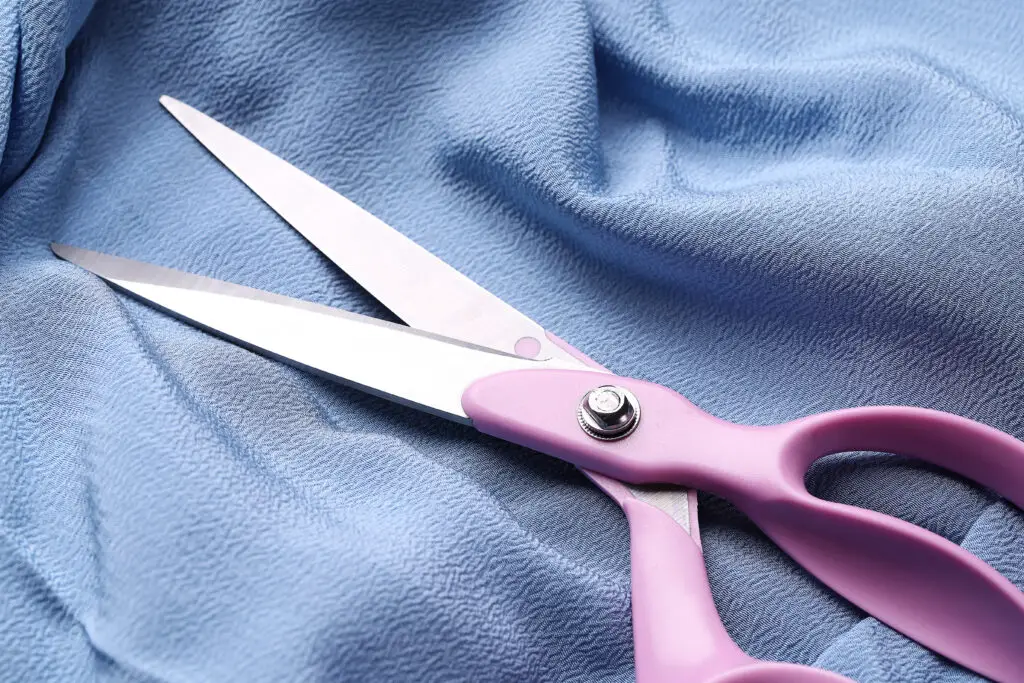
Fabric Shears
In this category of scissors, we have included all scissors designed to cut fabric.
Here we will talk about Dressmaking Scissors and Tailor Scissors (also called Tailor Shears), find out the difference between them, as well as about Pinking Shears and their advantages in using to create sewing projects.
Dressmaking Scissors
This pair of scissors is designed exclusively for cutting fabric. They have longer blades than tailor’s shears and more pointed ends. The average length of cutting scissors is 8-15 inches (for tailor shears this length rarely exceeds 9 inches).
A feature of dressmaking scissors is the angle at which the blade branches touch the axis of the wheels, it is 60 ° (for tailor shears this angle is sharper and is 45°). In addition, this pair has a narrower lower branch.
This slope and design features allow the dressmaking scissors to minimally tear the fabric from the work surface and thereby increase the accuracy of the cut.
It is also worth paying attention to the fact that specific pairs of shears are used for fabrics of different thicknesses:
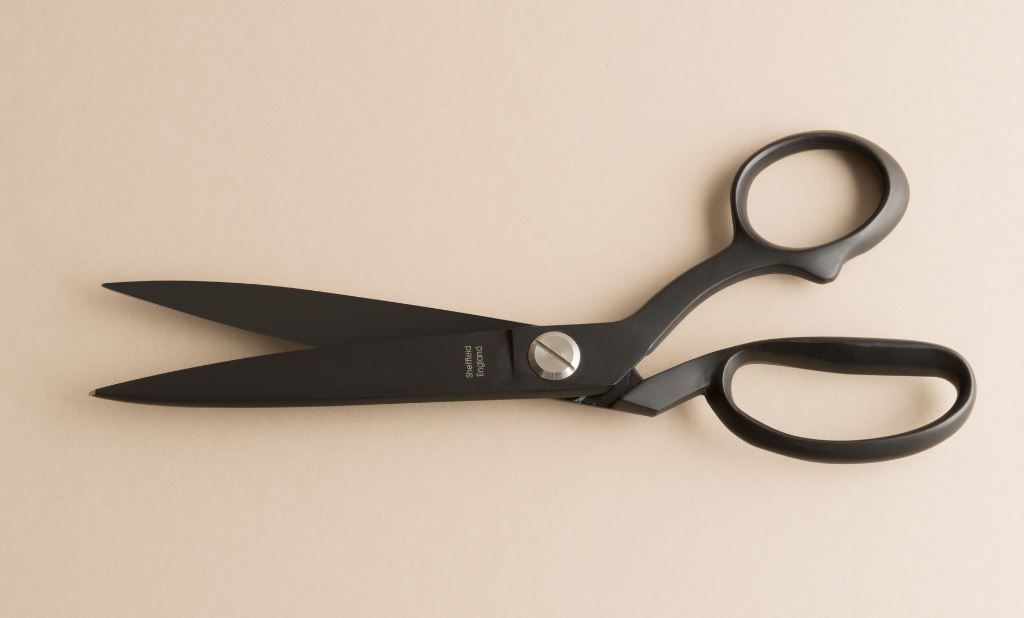
For light and medium fabrics
Fabric shears with thin and sharply ground blades 8-9 inches long are optimal for light and medium-weight fabrics.
For sliding fabrics
Sharpening is especially important for sliding fabrics: shears with notches on the blades will tightly fix silk or chiffon with blades.
For heavy fabrics or several layers of fabric
Heavy-duty scissors with reinforced and elongated blades are used to cut thicker fabric or even multiple layers of fabric.
Tailor Shears
So, now we know that tailor’s shears are shorter and lighter than dressmaking scissors and differ from them in structure.
What exactly are tailor’s shears useful for?
These fabric shears are more functional and necessary for cutting small shaped sections, fitting parts during sewing, snipping seam allowances, making incisions, and other similar work of fabric cutting.
Even though tailor shears are made specifically to cut fabric, some people use fabric shears for cutting paper patterns or as craft or paper scissors. There is an opinion that, in addition to fabrics, it is not recommended to cut anything else with fabric shears, since their blades can quickly blunt.
It can be noted that among the tailor scissors, there are many left-handed scissors. Compared to other cutting tools for sewing, tailor’s shears are much more often made in left-handed versions, and such fabric shears are popular. Therefore, if you need left-handed scissors, you can always find a model that you like among the tailor’s scissors.
Pinking Shears
Pinking shears (or zig-zag scissors) are designed for trimming edges of fabric or seam allowances. Processing the edges of the fabric with zig-zag scissors turns into a much more pleasant and simple activity, especially with easily crumbling fabrics.
Firstly, these shears allow you to process the edges of fabrics without sewing the edges on an overlock or sewing machine.
Secondly, the zig-zag shape is used for the decorative design of sections of non-crumbling fabrics. Pinking shears are ideal for processing elements of dense coat fabrics, loden, woolen cloth, and tweed.
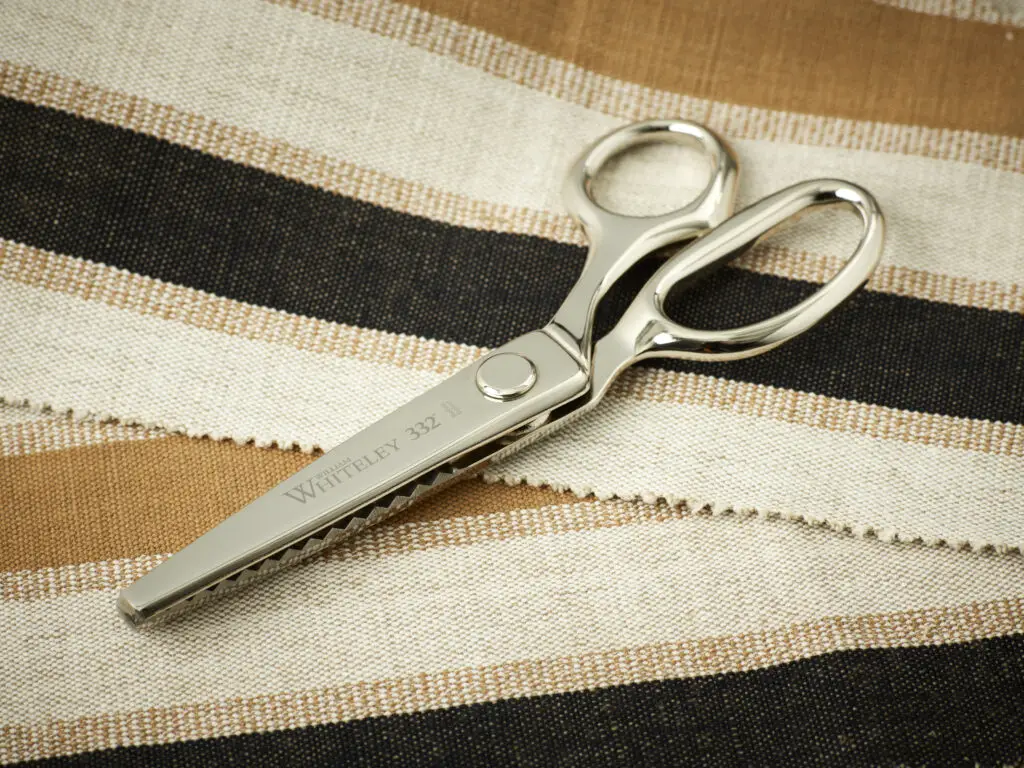
Thirdly, these shears can be used to grade seam allowances down or to process internal sections of even completely non-crumbling fabrics, so they will look neater.
Small pinking shears are better suited for fabric and heavy-duty pinking shears are ideal for crafts made of felt and fleece.
It is necessary to pay attention to the adjustable screw. If there is such an adjustment, then the pinking shears will last longer and their course can always be adjusted according to individual preferences.
Electric fabric scissors
Electric fabric scissors are special scissors that run on electricity or batteries. They have a motor inside that helps cut fabric and other things really easily and neatly.
In electric scissors, only the upper blade is movable, and the lower one remains in place, therefore, when using them, it is necessary to carry out only along the incision line.
These scissors are great for sewing and crafting because they make cutting a lot easier and faster, especially if you have to cut a lot of fabric or materials. Some of them don’t even need to be plugged in, so you can use them anywhere. They’re like magic scissors for sewing!
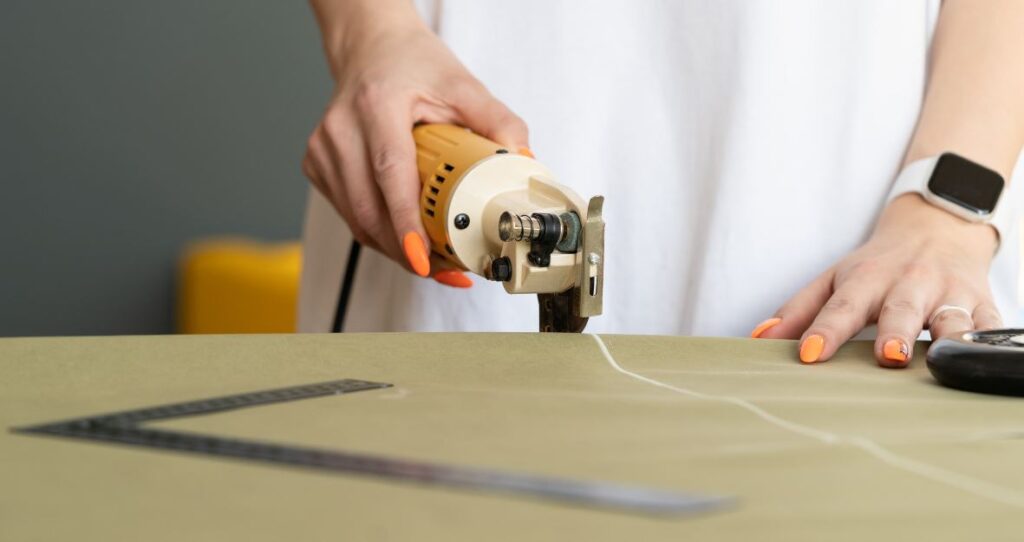
Today there is a huge variety of fabric shears in different versions and for different types of fabric, so you can easily pick up fabric shears that meet all your needs and requests, whether it’s left-handed pinking shears, or angled fabric scissors, heavy-duty dressmaking scissors or simple fabric shears.
Sewing scissors for needlework
Every kind of needlework, be it embroidery, patchwork, or applique, requires a special model of scissors. How do needlework tools differ from ordinary sewing scissors? Let’s find out about it.
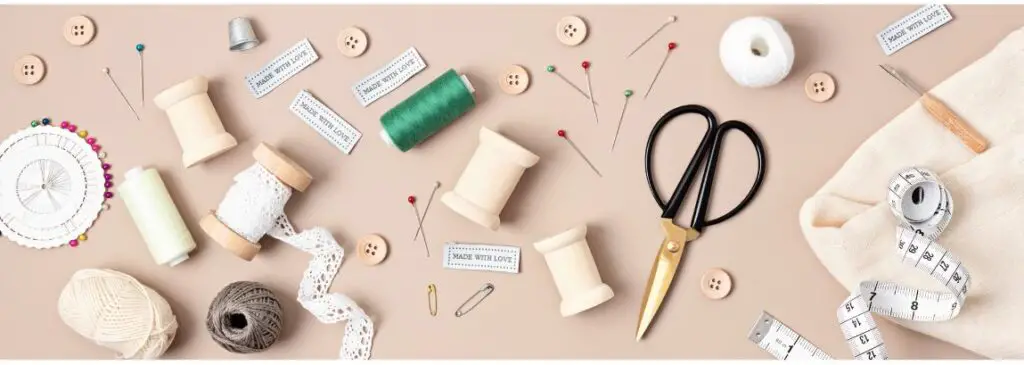
This large group of sewing tools includes models of the most unusual and bizarre shapes.
We will talk about cutting tools such as rotary cutters, duckbill scissors, and embroidery scissors and find out what kind of work they are needed for.
Rotary Cutters and other patchwork tools
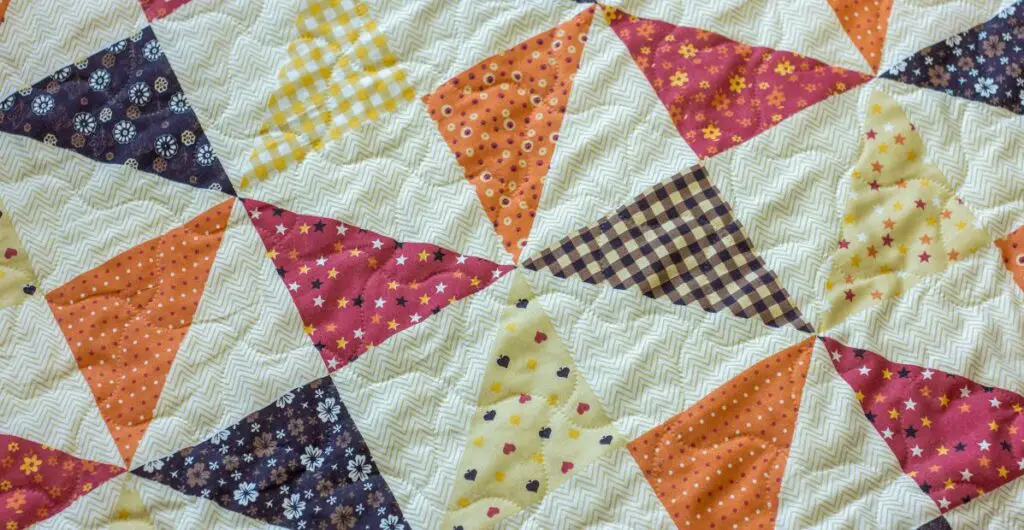
Patchwork is a needlework technique in which a canvas or a sewing product is made, or rather, sewn, from pieces of fabric.
A rotary cutter is one of the most popular cutting tools for patchwork sewing.
For patchwork work, you should stock up on basic tools:
- Rotary cutter
- Patchwork Scissors
- Cutting mat
- Quilting ruler
Rotary cutter
A rotary cutter is the essential cutting tool in patchwork sewing. The rotary cutter has a circular blade that cuts through the fabric, turning around its axis during the movement of the handle. On the body of the rotary cutter, as a rule, there is a platform with rollers adjacent close to the fabric.
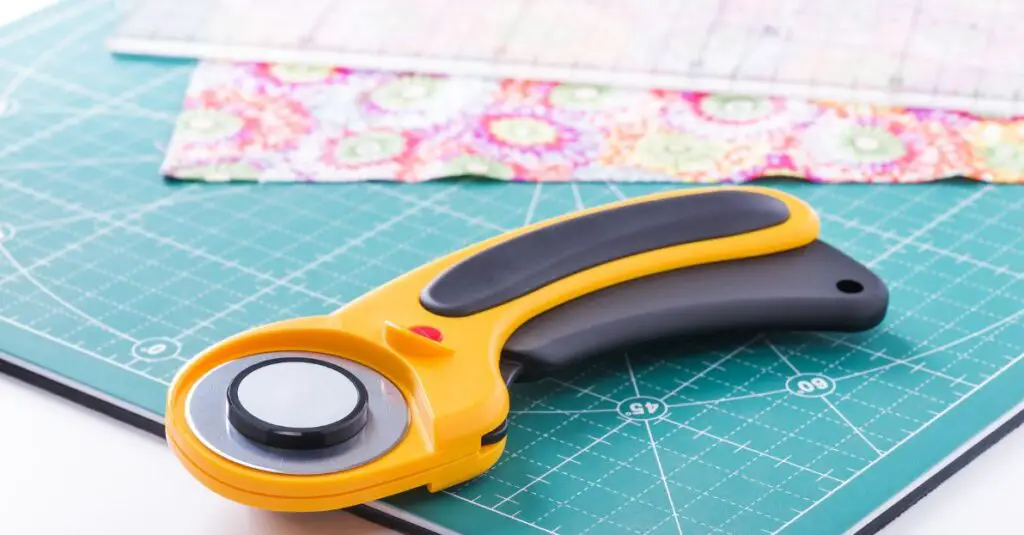
Rotary cutters can cut several layers of fabric at the same time without displacement, which is indispensable when cutting small rectangular parts, especially for working in the patchwork technique.
It is worth noting that the main disadvantage of rotary cutters is the inability to work with curved shapes so as not to spoil the fabric. If there are small rounded lines on the sewing patterns, then it will be difficult to cut them using a rotary cutter. You can’t do it without fabric scissors.
Patchwork scissors
Despite the fact that the essential cutting tool in patchwork is a rotary cutter, in this kind of needlework, patchwork scissors are also needed.
Patchwork scissors are special scissors used in quilting and sewing. They have a unique design with a zigzag or wavy edge instead of a straight edge. These wavy edges create decorative cuts when you use them to trim fabric pieces for quilts and crafts.
They’re handy for making fabric edges look pretty and can add a nice touch to your sewing projects. So, they’re like fancy scissors for making quilts and crafts look extra special.
A special cutting mat
A special mat is used to ensure that the blade of the rotary cutter does not blunt quickly and the working surface is not damaged. A cutting mat is an indispensable tool, it is better to choose rubber or self-healing mats, you can cut fabric rolled into 3-4 layers on them.
In order for the cutting mat to last as long as possible, you should remember a few rules: it is restored only from light cuts, and you do not need to cut fabric in the same place.
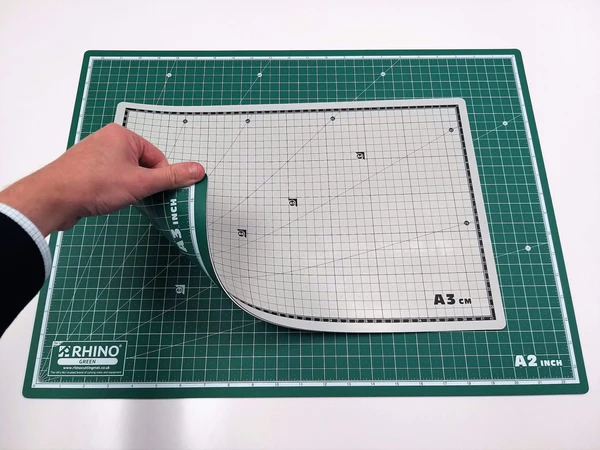
In no case can it be ironed – the self-healing mat does not withstand high temperatures. Also, you can not put heavy objects on it.
Patchwork or Quilting ruler
Patchwork (or quilting ruler) is designed to work with a rotary cutter on a cutting mat. These rulers are made of durable transparent acrylics of sufficient thickness. Thanks to their transparency, you will be able to see your sewing pattern well when cutting and take into account, for example, the pattern pieces of the fabric and its individual details.

Due to the strength of the material from which the rulers are made and their thickness, you can not worry about damaging them with a rotary cutter during the cutting process.
Rotary cutters are much sharper than scissors, so you should be more careful when using a rotary cutter. Like any dangerous tool, it requires very careful handling. Never leave the rotary cutters open! Use a special fuse and hide it from children.
Which rotary cutter to choose?
People who are fond of patchwork sewing recommend buying two rotary cutters, one with a small blade diameter, and the second with a large diameter.
A rotary cutter with a small blade diameter is suitable for cutting small pattern pieces. It is characterized by maneuverability, which is especially important when cutting curly flaps.
A rotary cutter with a large diameter of the cutting blade is necessary for cutting in a straight line. It is convenient to cut thick fabric.
Embroidery scissors
Embroidery is a common needlework art of decorating all kinds of fabrics and materials with a variety of patterns.
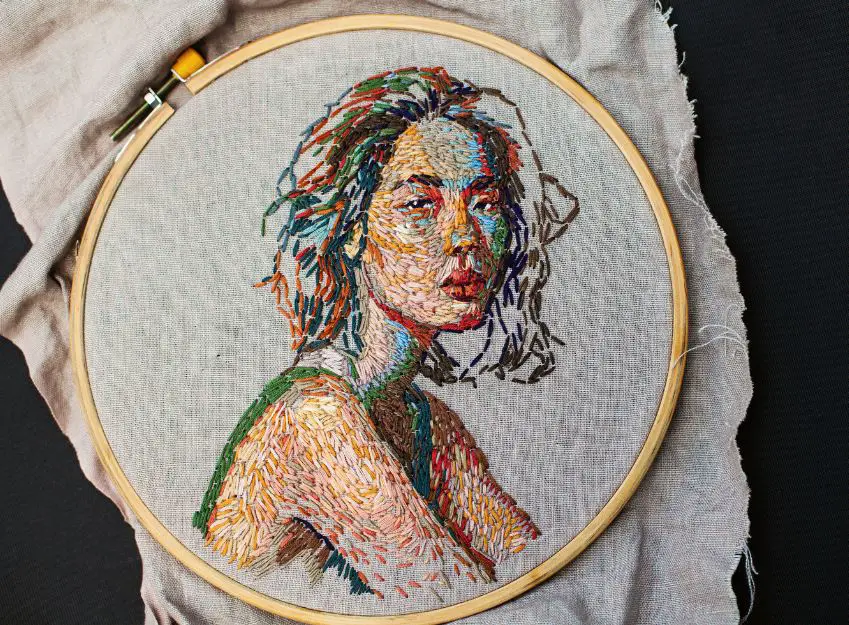
The main tools and materials for embroidery work are needles, thread, embroidery frames, and scissors.
Good embroidery scissors are just as important as a needle and thread.
Embroidery scissors – these are small scissors with a curved shape and long thin blades, which are very convenient to pick up the thread that needs to be cut.
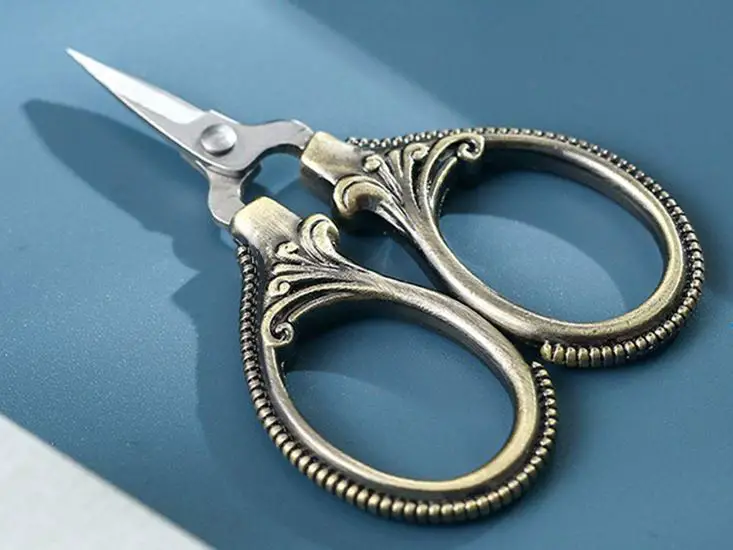
It is very important that the blades of the embroidery scissors are very sharp to prevent the splitting of the cut threads.
Embroidery scissors are an indispensable assistant in machine embroidery. These small scissors are also used for small sewing work and thread cutting.
Duckbill scissors for applique work
Appliqué is a technique of decorative and applied art based on gluing or sewing patterns, figures, and other decorative elements of decoration on background material.
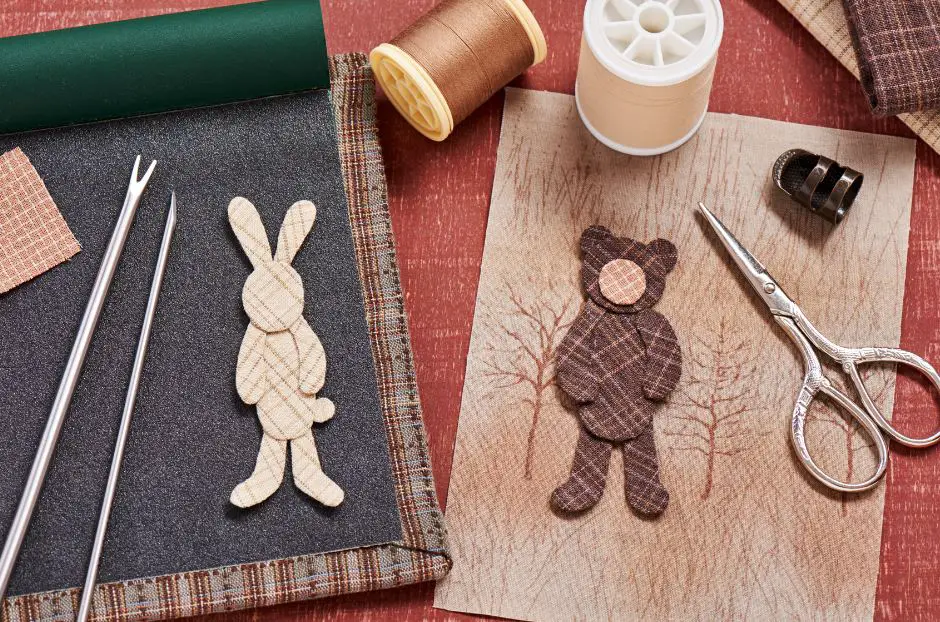
Duckbill scissors are a great tool for cutting small and tight areas on appliqué.
Duckbill scissors have a special shape that protects the application from damage.
One blade of duckbill scissors has the shape of a spatula, which allows you to cut the fabric of the application as close as possible to the stitch without damaging it.
These are the favorite pair of scissors of many people who make appliqué projects.
Additional cutting tools for sewing
In this part of the article, we will talk about scissors for cutting paper and some special tools for cutting threads and open seams, such as thread cutters and seam rippers.
Paper scissors
Paper scissors are an ordinary pair of scissors for cutting paper.
Since fabric shears are specially used to cut fabric, you will need paper scissors to quickly and accurately cut paper sewing patterns and other templates, cut off the ends of threads, and perform most operations in the absence of special cutting tools for sewing.

It is not recommended to cut paper patterns with fabric scissors, because these scissors are specially made for cutting fabric. You can use ordinary paper scissors to cut paper.
It is not particularly important what kind of paper scissors will be, the main thing is that they can ensure an even cut along the entire length of the paper and do not jam the edges of the paper.
The main requirement for paper scissors is that they should be light and comfortable in your hand.
Thread snips
Thread snips (or snippets) are used for cutting threads, cutting loops, making notches and other small sewing work. These are spring scissors, they have a small size and short blades.

It seems that you can cut random threads with any handy scissors, but professionals do not allow this. For these purposes, always have these small and sharp thread snips at hand.
The thread snips can be metal or plastic. The most important thing when choosing is that the blades close well, and the ends are sharp since the main working part is the ends.
Seam ripper
A seam ripper is a very useful tool, with the help of a seam ripper you can carefully and quickly open any seam, remove an unnecessary thread, or cut a button loop.
It has an unusual shape, which is great for removing thread without compromising the fabric structure.
A seam ripper has two ends: one pointed from the inside, with a tip, and one blunted. This structure allows you to cling to any thread in any hard-to-reach places, and as a result, the fabric looks almost untouched.
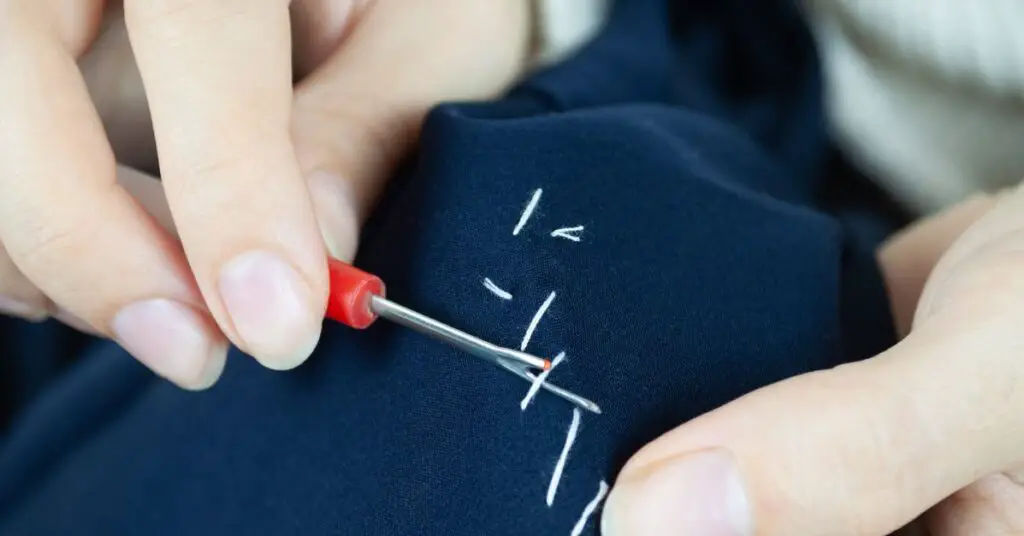
Different manufacturers can produce seam rippers of different sizes. There are two main types: standard and enlarged.
Larger devices are more often used for cutting seams with larger and denser sewing threads. This type of seam ripper is used to work with dense and heavy fabrics. And the standard ones are designed to remove seams with thinner threads on lighter fabrics.
Before you get to work, you need to determine the density of the fabric and the strength of the seams, and depending on this, choose a seam ripper.
There are special seam rippers for embroidery work. They help to remove many stitches at once.
The seam ripper is a device with a sharp blade and you need to be careful with him.
The reason that the edge of the blade is very well sharpened, the main advice is not to neglect safety regulations and it is better to keep a seam ripper away from children.
Here is a video how to use a seam ripper:
How to choose cutting tools for sewing?
Before buying any cutting tool, it is necessary to pay attention to the following points:

The price of a cutting tool
Good cutting tools for sewing cannot be cheap, because only high-quality materials and special technologies are required for their manufacture.
It is convenient for you to use this tool
It is necessary to test cutting tools for sewing before buying, feel them in your hand, and try to cut fabric with them to check the sharpness of the blades. Take a piece of cloth with you to do this
The cutting tool should cut well
High-quality cutting tools for sewing should cut the fabric well and smoothly over the entire surface of the blade. With such cutting tools, sewing projects can be made at a high level.
Material of the cutting tool
Choose cutting tools for sewing whose blades are made only of high-quality stainless steel. These tools will last you for many years, and the blades will not have to be sharpened often.
Pay attention to the material from which the tool handle is made, cheap plastic parts will quickly fail.
Conclusion
As we can see, there is a huge variety of cutting tools for sewing: different types of sewing scissors used to cut fabrics, special tools with different blade shapes for needlework, and different types of scissors to cut threads or other small sewing work.
I hope this article has helped you learn more about cutting tools used in sewing.
If you still have any questions, ask them in the comments section below, and don’t forget to share this article with your like-minded people so they can also learn more about sewing tools for example Measuring Tools In Sewing.
Thanks for reading!
FAQ
How can I test a cutting tool for sewing if I buy it online?
In this case, it is better to buy in official branded stores or on marketplaces where this brand is officially represented.
In this case, you can be sure that the tool will be of good quality and with sharp blades.
Can I sharpen the blades myself?
Experienced specialists do not advise you to sharpen cutting tools for sewing yourself, because special equipment is needed for this.
Sharp blades are the most important part of a cutting tool, therefore, in order for the blade to be sharp, it must be sharpened at a special angle on special equipment.
Therefore, it is recommended to sharpen cutting tools for sewing in special workshops.
What should I do to keep the blades of the cutting tools for sewing sharp for as long as possible?
To keep your cutting tools for sewing sharp for as long as possible, clean them of lint and dust before and after work.
Store your cutting tools for sewing in a case in a dry place horizontally.
Do not use the cutting tool to work with materials for which it is not intended.
Do not cut wet fabrics, the blade of your cutting tool may become covered with rust and your tool will become unusable.
These simple rules will allow the blades of your tool to stay sharp for as long as possible.

Hi everyone and welcome to my blog!
My name is Liz, and I started sewing when my son was born. First I repaired the holes in children’s pants, then I dared to do more challenging projects like sewing home decor and children’s clothing. Now it is my hobby where I come to rest, let my creativity run wild, and create things that please me and enhance my home.
I would love to help other sewing beginners and enthusiasts through my blog by sharing tips and tricks for this great hobby.
